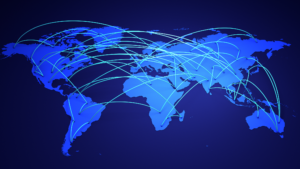
GIS (geographic information systems) is at the heart of what we do at Connectbase. In fact, the global development and growth of GIS has deep roots to the rise of the internet, and now Connectbase’s The Connected World platform is leveraging GIS to continue developing the digital infrastructure that powers the internet. GIS helps us curate the “location truth” for network operators and managed service providers to understand how best to buy and sell connectivity, so the industry’s fiber, wireless, copper and coax gets into the right hands at the right price.
For GIS Day, we’re taking a look at GIS through the lens of Yixuan Wang, longtime Data Scientist at Connectbase who led the team who built the recently launched self-service NearNet analysis functionality. With a bachelor’s degree in Geography and Astronomy from the University of Arizona and a master’s in GIS from Clark University, Yixuan is part of Connectbase’s GIS team of about 30 data scientists and analysts. His LinkedIn profile sports the tagline: “Spatial thinking changes the world.”
Keep reading for a Q&A with Yixuan.
Let’s start with an easy one! What is GIS?
That’s definitely one of the most common questions I get when I tell people that’s what I do. The simplest answer is, it’s a digital mapping of our entire planet. GIS tries to understand the physical and spatial relationship of the planet with digital mapping. That’s now extending out to what NASA does for Mars and other planets, so we can apply the same concept to other planets.
GIS is still a relatively new concept. It started in the late 60s in the military and academic fields. When the internet started booming in the 90s and early 2000s, that’s when you see a lot of the GIS applications start emerging. Now, GIS is changing every industry with information science.
What drew you to Connectbase?
The fundamental concept behind Connectbase is powered by GIS. Our platform has the ability to map out the entire total addressable market and understand which businesses service providers are able to serve. It’s all about understanding how the telecom buying and selling market works in this digital, modern world. When I first heard of Connectbase, I saw that Founder & CEO Ben Edmond shares a passion for digitally transforming how the telecom industry works.
I have a very exciting position at Connectbase. I’m able to continue leveraging GIS technology combined with the cutting-edge data science process to help our platform become smarter.
What does the typical day look like for a GIS team member at Connectbase?
Every day, we work with spatial data to build “location truth” and create the latest user experience for the platform. We’re continuing to enhance the data insights available to our customers. The data we’re collecting, managing and enhancing everyday is the backbone of The Connected World.
Every day, there’s tons of data coming from various sources — governments, nonprofit organizations, data vendors and more — and they all become our data sources. GIS team members analyze data from the sources, knowing the patterns, what can be used, where the anomalies are, etc. When we know all of those answers, we have to blend everything together and deliver it to our data warehouse or customer-facing data services. The middle part is the most complex. GIS is all about knowing how to process spatial data. Everything we touch is spatial-related, down to the location data.
Tell us about one project you’ve worked on at Connectbase that you’re especially proud of.
Our new fully automated NearNet analysis functionality empowers customers to complete NearNet analysis themselves. We’re able to help customers quickly detect all other serviceable locations and addresses that they’re able to serve within a certain distance from their footprint or within their footprint.
This functionality offers the Right-of-Way (ROW) option for NearNet Analysis. In the telecom world, the path mainly consists of public transportation networks — roads, streets, highways. Now, our paths can follow railroads or other types of networks as long as they have the ROW to build. In addition, we’re able to help customers identify the entire serviceable market quickly by providing them with intelligence about how far they want to build a fiber extension from an existing splice point to all Near Net locations. This info provides a much more accurate distance compared to traditional Line-of-Sight (LOS). We also add impediment data. Impediments, such as highway crossings, railroad crossings, historical districts, rivers and bridges, cause higher costs than anticipated. We’re able to provide all of that information based on GIS and give the customer all of this decision-driving data.
What’s the biggest trend within GIS right now?
The growth of the GIS field itself and SasS based GIS applications. GIS has a strong relationship with each industry, and all industries need more GIS professionals throughout the next 10-20 years. GIS follows the same trend of each industry requiring data science.
One of my friends is working in GIS at the hospital. They’re doing disease research to look at geographic trending on how a disease originates. Another friend is leveraging GIS for the federal government, looking at remote satellite imagery of urban developments and more. Another friend is using GIS as part of consulting groups for the banking industry.
Anything else you’d like people to know about GIS?
I believe that spatial thinking changes the world. We’re leveraging technology and data science to answer so many questions. GIS is a fascinating technology that I’m so passionate about.

